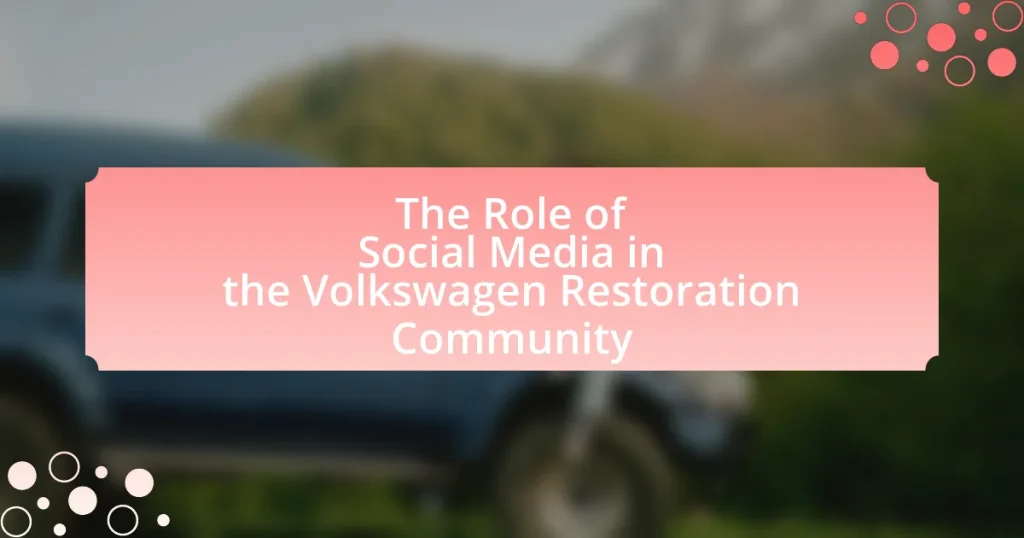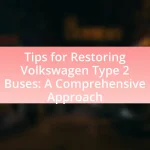The article examines the significant role of social media within the Volkswagen restoration community, highlighting how platforms like Facebook, Instagram, and dedicated forums facilitate communication, knowledge sharing, and collaboration among enthusiasts. It discusses the transformation of the restoration process through enhanced access to information, sourcing of parts, and community engagement. Key benefits include improved project outcomes, mentorship opportunities, and the ability to showcase restoration journeys. The article also addresses challenges such as misinformation and privacy concerns, while providing best practices for restorers to effectively engage with the community online.
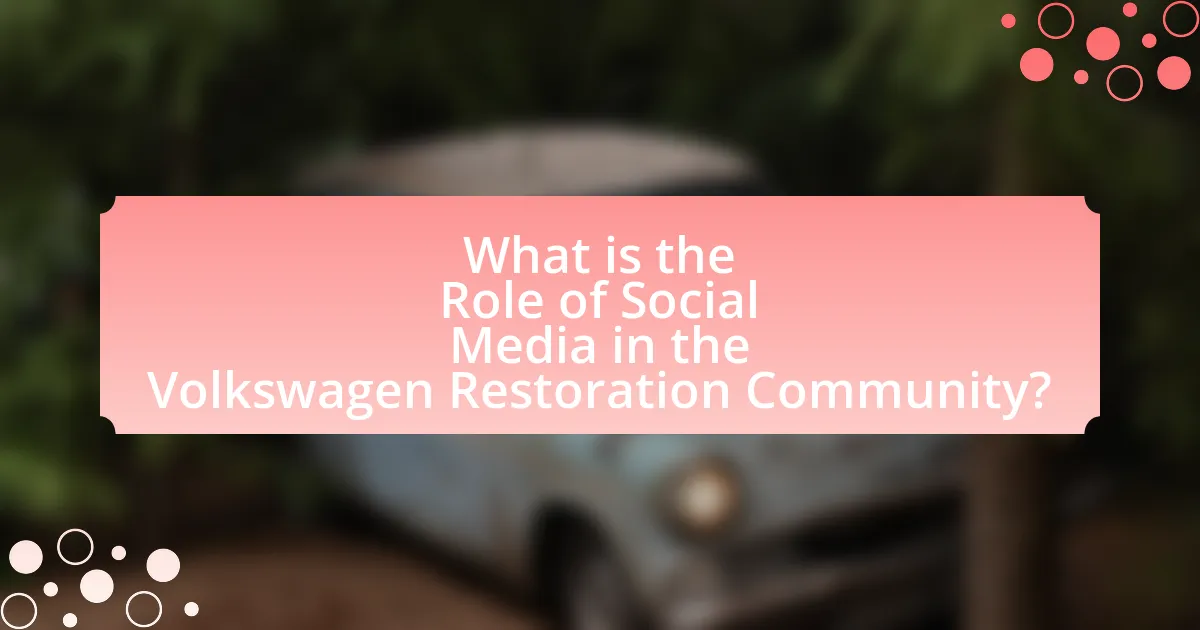
What is the Role of Social Media in the Volkswagen Restoration Community?
Social media plays a crucial role in the Volkswagen restoration community by facilitating communication, knowledge sharing, and collaboration among enthusiasts and restorers. Platforms like Facebook, Instagram, and dedicated forums allow members to exchange tips, showcase projects, and seek advice, creating a supportive network. For instance, Facebook groups specifically focused on Volkswagen restoration have thousands of members who actively post updates, share resources, and provide feedback on restoration techniques. This connectivity enhances the overall restoration experience, making it easier for individuals to access information and connect with others who share their passion for Volkswagen vehicles.
How has social media transformed the Volkswagen restoration process?
Social media has transformed the Volkswagen restoration process by facilitating knowledge sharing and community engagement among enthusiasts. Platforms like Instagram, Facebook, and YouTube allow restorers to showcase their projects, share techniques, and seek advice from a global audience. This connectivity has led to the rapid dissemination of restoration tips, access to rare parts, and collaboration opportunities, significantly enhancing the efficiency and creativity of restoration efforts. For instance, restoration groups on Facebook often feature thousands of members who actively exchange information, leading to improved restoration outcomes and a stronger sense of community among Volkswagen enthusiasts.
What platforms are most commonly used in the Volkswagen restoration community?
The most commonly used platforms in the Volkswagen restoration community are Facebook, Instagram, and dedicated forums such as TheSamba and VWVortex. Facebook groups provide a space for enthusiasts to share restoration tips, project updates, and connect with others. Instagram allows users to showcase their restoration projects visually, attracting a wide audience. Forums like TheSamba and VWVortex offer in-depth discussions, technical advice, and a wealth of archived information specific to Volkswagen restoration. These platforms facilitate community engagement and knowledge sharing among Volkswagen enthusiasts.
How do these platforms facilitate communication among restorers?
Social media platforms facilitate communication among restorers by providing dedicated spaces for sharing knowledge, experiences, and resources. These platforms enable restorers to connect through forums, groups, and direct messaging, allowing for real-time discussions and collaboration on restoration projects. For instance, platforms like Facebook and Instagram host specialized groups where members can post questions, share progress updates, and exchange tips, fostering a sense of community. Additionally, the visual nature of these platforms allows restorers to showcase their work, receive feedback, and inspire others, enhancing the overall learning experience within the Volkswagen restoration community.
What are the key benefits of using social media for Volkswagen restorers?
The key benefits of using social media for Volkswagen restorers include enhanced community engagement, access to a wider audience, and the ability to share knowledge and resources. Social media platforms allow restorers to connect with fellow enthusiasts, share restoration tips, and showcase their projects, fostering a sense of community. According to a study by the Pew Research Center, 69% of adults in the U.S. use social media, providing a vast audience for restorers to reach potential buyers and collaborators. Furthermore, platforms like Facebook and Instagram enable restorers to share before-and-after photos, attracting attention and feedback that can improve their work.
How does social media enhance knowledge sharing among enthusiasts?
Social media enhances knowledge sharing among enthusiasts by providing platforms for real-time communication and collaboration. These platforms allow users to share experiences, techniques, and resources related to Volkswagen restoration, fostering a community of learning. For instance, forums and groups on Facebook or dedicated websites enable members to post questions, share tutorials, and showcase their projects, which can lead to immediate feedback and advice from peers. Research indicates that 70% of users find social media helpful for learning new skills, demonstrating its effectiveness in facilitating knowledge exchange among enthusiasts.
What role does social media play in sourcing parts and resources?
Social media plays a crucial role in sourcing parts and resources for the Volkswagen restoration community by facilitating connections among enthusiasts, suppliers, and manufacturers. Platforms like Facebook, Instagram, and specialized forums enable users to share information about available parts, recommend trusted vendors, and post inquiries for specific components. For instance, Facebook groups dedicated to Volkswagen restoration often feature members who list parts for sale or trade, significantly increasing the accessibility of hard-to-find items. Additionally, social media allows for real-time communication and collaboration, enabling restorers to quickly locate resources and share restoration tips, which enhances the overall efficiency of sourcing parts.
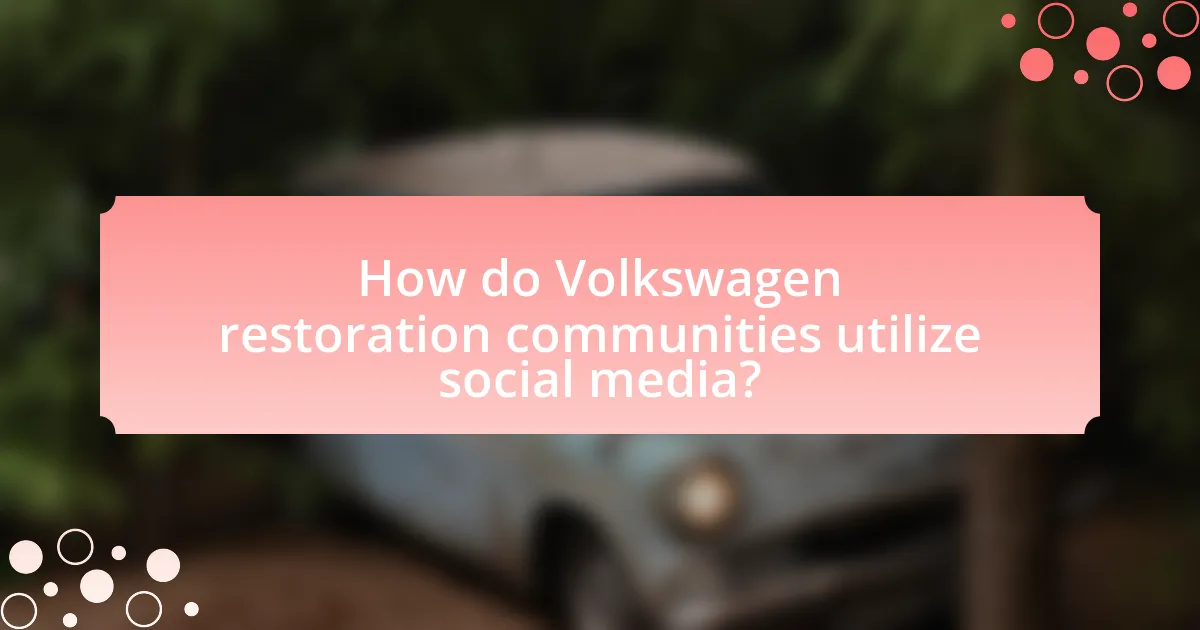
How do Volkswagen restoration communities utilize social media?
Volkswagen restoration communities utilize social media primarily for sharing knowledge, resources, and project updates. These communities create platforms on sites like Facebook, Instagram, and forums where members can post restoration tips, showcase their projects, and seek advice from fellow enthusiasts. For instance, Facebook groups dedicated to Volkswagen restoration often feature thousands of members who actively engage in discussions, share photos of their work, and provide feedback on techniques and parts sourcing. This collaborative environment fosters a sense of community and accelerates the learning curve for both novice and experienced restorers, as evidenced by the proliferation of restoration guides and tutorials shared within these groups.
What types of content are shared within these communities?
Within the Volkswagen restoration community, members share various types of content, including restoration project updates, technical advice, parts sourcing information, and community events. Restoration project updates often feature before-and-after photos, showcasing the transformation of vehicles, while technical advice includes tips on repair techniques and troubleshooting common issues. Parts sourcing information helps members locate rare or discontinued components, and community events promote gatherings, meetups, and shows where enthusiasts can connect. This content fosters collaboration and knowledge sharing, essential for successful restorations and community building.
How do restorers showcase their projects on social media?
Restorers showcase their projects on social media by posting before-and-after photos, detailed progress updates, and engaging videos that highlight their restoration techniques. These posts often include captions that explain the challenges faced and the solutions implemented, allowing followers to appreciate the craftsmanship involved. For instance, restorers frequently use platforms like Instagram and Facebook to share time-lapse videos of the restoration process, which can attract a larger audience and foster community engagement. This method not only demonstrates their skills but also builds a network of enthusiasts who share similar interests in Volkswagen restorations.
What impact does user-generated content have on community engagement?
User-generated content significantly enhances community engagement by fostering a sense of belonging and participation among members. In the context of the Volkswagen restoration community, this type of content encourages individuals to share their experiences, projects, and knowledge, which in turn stimulates interaction and collaboration. Research indicates that communities with high levels of user-generated content experience increased member retention and activity; for instance, a study by Nielsen found that 84% of consumers trust online reviews as much as personal recommendations, highlighting the influence of shared content on community dynamics.
How do social media groups foster collaboration among restorers?
Social media groups foster collaboration among restorers by providing a platform for sharing knowledge, resources, and experiences. These groups enable restorers to connect with others who have similar interests, facilitating the exchange of techniques, tips, and best practices. For instance, members can post questions about specific restoration challenges and receive immediate feedback from experienced restorers, enhancing problem-solving capabilities. Additionally, social media groups often organize virtual meetups and collaborative projects, which further strengthen community ties and encourage teamwork. This collaborative environment is supported by the fact that over 70% of restorers report improved skills and knowledge through interactions in these online communities.
What are the benefits of joining online restoration groups?
Joining online restoration groups provides access to a wealth of knowledge, support, and resources specific to Volkswagen restoration. Members benefit from shared experiences, expert advice, and troubleshooting tips that can significantly enhance their restoration projects. For instance, a survey by the Automotive Restoration Association found that 78% of participants reported improved project outcomes due to insights gained from online communities. Additionally, these groups foster connections with fellow enthusiasts, creating a sense of camaraderie and motivation that can be crucial during challenging restoration phases.
How do these groups facilitate mentorship and support?
Social media groups in the Volkswagen restoration community facilitate mentorship and support by creating platforms for experienced restorers to share knowledge and advice with newcomers. These groups often feature forums, live chats, and video tutorials where members can ask questions, receive feedback, and showcase their projects. For instance, platforms like Facebook and Instagram allow users to post detailed restoration processes, enabling peer-to-peer learning. Additionally, many groups organize virtual meetups and workshops, fostering a sense of community and collaboration that enhances the learning experience. This structured interaction not only builds skills but also strengthens relationships among members, contributing to a supportive environment for all involved.
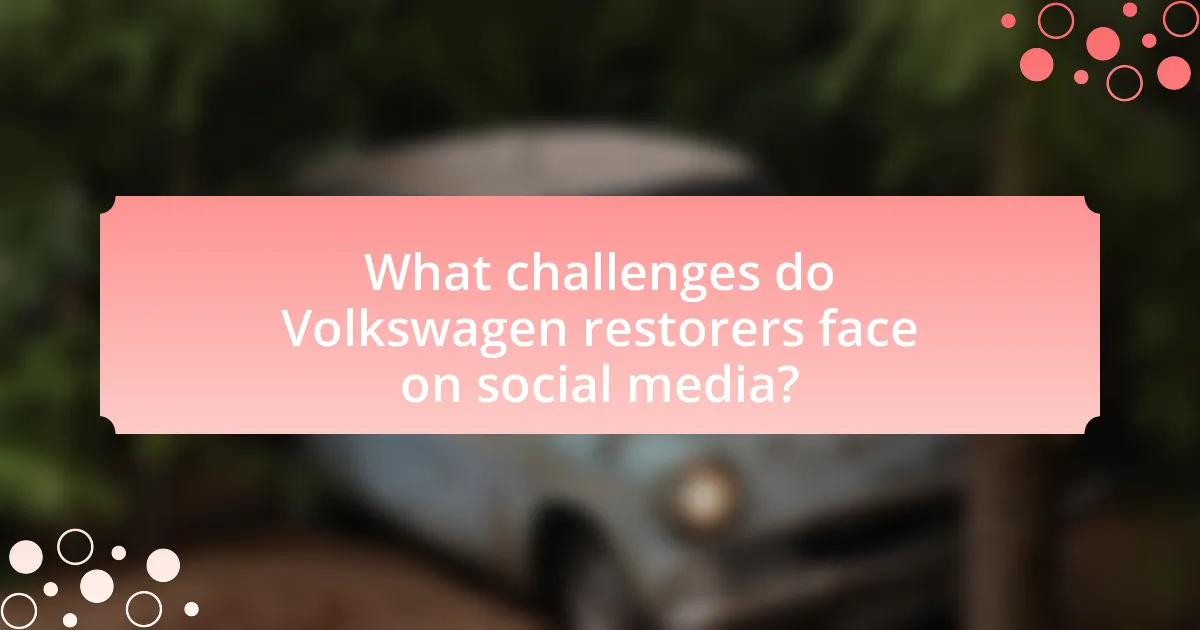
What challenges do Volkswagen restorers face on social media?
Volkswagen restorers face challenges on social media primarily due to misinformation and the difficulty in sourcing authentic parts. Misinformation can lead to confusion regarding restoration techniques and best practices, as various users may share conflicting advice or unverified information. Additionally, sourcing authentic parts is complicated by the prevalence of counterfeit components, which can be misrepresented in online marketplaces. This situation is exacerbated by the vast number of platforms where restorers seek information, making it hard to verify the credibility of sources.
What are the common misconceptions about Volkswagen restoration shared online?
Common misconceptions about Volkswagen restoration shared online include the belief that all parts are readily available and that restoration is a straightforward process. Many enthusiasts assume that vintage Volkswagen parts can be easily sourced, but in reality, certain components are rare and may require extensive searching or custom fabrication. Additionally, the notion that restoration is simply a matter of replacing old parts overlooks the complexities involved, such as structural integrity, historical accuracy, and the need for specialized skills. These misconceptions can lead to unrealistic expectations and frustration among restorers, as highlighted by various online forums and restoration guides that emphasize the challenges of sourcing parts and the detailed work required for a successful restoration.
How can misinformation affect restoration projects?
Misinformation can significantly hinder restoration projects by leading to poor decision-making and resource misallocation. For instance, incorrect information about the availability of parts or restoration techniques can result in wasted time and financial resources, as enthusiasts may invest in unnecessary or incompatible components. A study by the Pew Research Center found that 64% of Americans believe misinformation has caused confusion about important issues, which can directly impact the Volkswagen restoration community by spreading false claims about best practices or the authenticity of parts. This confusion can ultimately derail projects, diminish community trust, and reduce the overall quality of restorations.
What strategies can restorers use to verify information found on social media?
Restorers can verify information found on social media by cross-referencing details with reputable sources, such as official manufacturer websites, established automotive forums, and peer-reviewed publications. This strategy ensures that the information aligns with recognized standards and expert opinions. For instance, restorers can consult the Volkswagen Classic Parts program, which provides accurate specifications and parts availability, thereby confirming the authenticity of claims made on social media. Additionally, engaging with experienced members of the Volkswagen restoration community on platforms like dedicated forums or Facebook groups can provide insights and validation of the information shared. This collaborative approach enhances the reliability of the data and helps prevent misinformation.
How do privacy and safety concerns impact social media use in the restoration community?
Privacy and safety concerns significantly impact social media use in the restoration community by limiting the sharing of personal information and project details. Members often hesitate to post images or updates about their restoration projects due to fears of theft or misuse of their work. According to a survey conducted by the Pew Research Center, 64% of social media users have experienced concerns about their privacy, which leads to more cautious engagement in online communities. This cautious behavior can hinder collaboration and knowledge sharing, essential elements for enthusiasts in the Volkswagen restoration community.
What precautions should restorers take when sharing their projects online?
Restorers should take several precautions when sharing their projects online, including protecting their intellectual property, ensuring privacy, and maintaining safety. By watermarking images and avoiding the disclosure of proprietary techniques, restorers can safeguard their unique methods and designs. Additionally, they should be cautious about sharing personal information or location details that could compromise their safety or privacy. Furthermore, restorers should consider the potential for negative feedback or criticism and be prepared to engage constructively with their audience. These precautions help maintain a professional online presence while minimizing risks associated with sharing restoration projects.
How can restorers protect their personal information while engaging with the community?
Restorers can protect their personal information while engaging with the community by using pseudonyms and limiting the amount of personal data shared online. By adopting a pseudonym, restorers can maintain anonymity, reducing the risk of identity theft or unwanted attention. Additionally, they should avoid sharing sensitive information such as home addresses, phone numbers, or financial details in public forums or social media platforms. Research indicates that 60% of individuals have experienced privacy breaches due to oversharing on social media, highlighting the importance of cautious online behavior.
What best practices should Volkswagen restorers follow on social media?
Volkswagen restorers should prioritize authenticity and engagement on social media to effectively connect with their audience. Authenticity involves sharing genuine restoration stories, showcasing progress, and being transparent about challenges faced during the restoration process. Engagement can be achieved by responding to comments, asking for feedback, and participating in discussions within the Volkswagen community.
Additionally, restorers should utilize high-quality visuals, as studies show that posts with images receive 94% more views than those without. Consistent posting schedules help maintain audience interest, while using relevant hashtags can increase visibility and reach within the niche community. Following these best practices fosters a supportive environment and enhances the overall experience for both restorers and enthusiasts.
How can restorers effectively document their restoration journey online?
Restorers can effectively document their restoration journey online by utilizing social media platforms to share progress updates, photos, and videos of their work. By consistently posting content that showcases each stage of the restoration process, restorers engage their audience and build a community around their projects. For instance, platforms like Instagram and Facebook allow restorers to use hashtags relevant to Volkswagen restoration, which increases visibility and connects them with others in the same niche. Additionally, creating detailed captions that explain the techniques used and challenges faced enhances the educational value of the posts, fostering interaction and feedback from followers. This method not only showcases the restoration journey but also contributes to a collective knowledge base within the Volkswagen restoration community.
What tips can enhance engagement and interaction with followers?
To enhance engagement and interaction with followers, consistently create high-quality, relevant content that resonates with their interests. Engaging content can include tutorials, restoration tips, and behind-the-scenes insights into the Volkswagen restoration process, which fosters a sense of community. Additionally, actively responding to comments and messages encourages dialogue and builds relationships. Research shows that brands that engage with their audience through personalized responses see a 20% increase in customer satisfaction and loyalty. Utilizing polls, questions, and interactive posts can also stimulate participation, leading to a more vibrant community.
